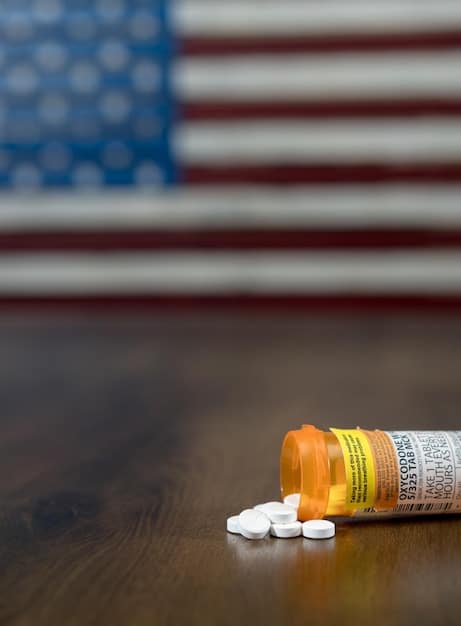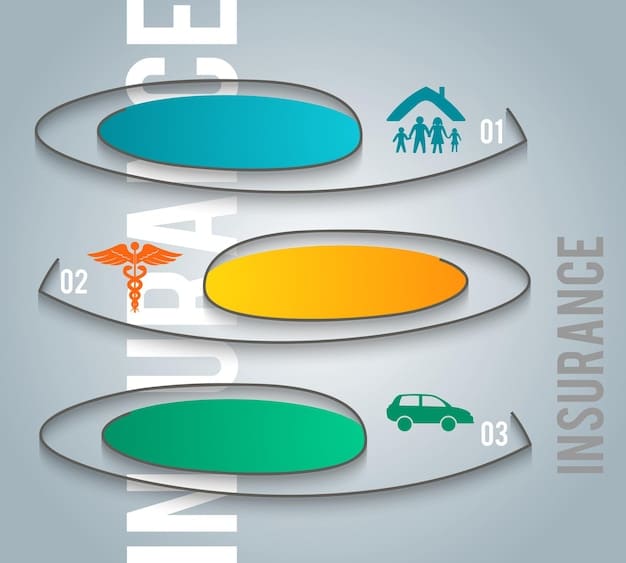The Ultimate Guide to Medicare Part D Benefits: Coverage, Costs, and Enrollment

Medicare Part D helps cover prescription drug costs for Medicare beneficiaries in the US, offering various plans with different premiums, deductibles, and drug formularies, allowing individuals to choose a plan that best meets their healthcare needs.
Navigating the complexities of healthcare can be daunting, especially when it comes to prescription drug coverage. The Ultimate Guide to Understanding and Utilizing Medicare Part D Benefits provides clarity and empowers you to make informed decisions about your healthcare. This guide walks you through everything you need to know about Part D.
Understanding Medicare Part D: An Overview
Medicare Part D, a crucial component of Medicare, focuses specifically on prescription drug coverage, offering a lifeline for beneficiaries managing their medication costs. It operates through private insurance companies that contract with Medicare, ensuring a wide array of plan options to suit diverse needs.
What Medicare Part D Covers
Medicare Part D is designed to help with the cost of prescription drugs. This coverage includes a wide range of medications, but it’s important to understand the details of what is typically covered.
- Prescription Medications: Part D plans generally cover most prescription drugs, including those you would pick up at your local pharmacy.
- Vaccinations: Many Part D plans also provide coverage for vaccinations, such as the flu shot and shingles vaccine.
- Medical Supplies: Some plans may extend coverage to certain medical supplies needed to administer medications, like syringes and alcohol swabs, but this varies by plan.
What Medicare Part D Doesn’t Cover
While Part D offers extensive coverage, some exceptions exist. Knowing what is not covered is just as important as knowing what is. In general, understanding these exclusions helps you plan for your healthcare needs effectively.
- Cosmetic Drugs: Drugs intended for cosmetic purposes, such as those used to treat wrinkles or hair loss, are typically not covered.
- Over-the-Counter Medications: Most over-the-counter medications are not included. However, some plans may offer coverage for certain over-the-counter drugs through mail-order programs.
- Weight Loss or Weight Gain Drugs: Drugs primarily used for weight loss or weight gain are generally excluded from coverage.
Medicare Part D is an important resource for managing prescription drug costs, offering a range of options to suit different healthcare needs. Understanding what is covered and what is not allows beneficiaries to make the most informed decisions about their healthcare.
Eligibility and Enrollment for Medicare Part D
Eligibility for Medicare Part D is closely tied to Medicare eligibility itself, making it a straightforward process for those already enrolled in Medicare. Understanding the enrollment periods and requirements is critical for those looking to gain access to prescription drug coverage.
Who is Eligible for Medicare Part D?
To be eligible for Medicare Part D, you must first be enrolled in Medicare Part A (hospital insurance) or Medicare Part B (medical insurance). This prerequisite ensures that Part D serves as a supplementary benefit to the foundational Medicare coverage. It’s designed for anyone who needs assistance with prescription drug costs.
When Can You Enroll in Medicare Part D?
Timing is key when it comes to enrolling in Medicare Part D. There are specific periods during which you can enroll to avoid penalties and ensure continuous coverage.
- Initial Enrollment Period (IEP): This period starts three months before the month you turn 65 and ends three months after. It’s the first opportunity to enroll in Part D when you become eligible for Medicare.
- Annual Enrollment Period (AEP): Also known as the open enrollment period, it runs from October 15 to December 7 each year. During this time, you can enroll, disenroll, or switch Part D plans.
- Special Enrollment Period (SEP): Certain situations, such as losing other creditable prescription drug coverage, can trigger a Special Enrollment Period, allowing you to enroll outside the standard periods.

Late Enrollment Penalties
Enrolling in Medicare Part D as soon as you’re eligible is essential to avoid potential late enrollment penalties. It’s an extra cost that’s added to your monthly premium for as long as you have Medicare drug coverage.
The penalty is calculated based on the number of months you delayed enrollment and can increase over time. The longer you wait, the higher the penalty. Therefore, it’s best to sign up for Part D when you’re first eligible to avoid this ongoing charge.
Understanding the eligibility requirements and enrollment periods for Medicare Part D is critical for getting the most out of your Medicare benefits and effectively managing your healthcare costs.
Understanding Medicare Part D Costs
Medicare Part D involves several types of costs that beneficiaries need to understand to manage their healthcare expenses effectively. These costs include premiums, deductibles, copayments, and coinsurance.
Premiums
The premium is the monthly fee you pay to be enrolled in a Medicare Part D plan. Premiums can vary widely between plans, depending on the coverage and benefits offered.
Some individuals with higher incomes may pay an additional amount on top of their plan premium, known as the Income-Related Monthly Adjustment Amount (IRMAA). This additional amount is determined by your modified adjusted gross income.
Deductibles
The deductible is the amount you must pay out-of-pocket for your prescription drugs before your Part D plan starts to pay its share. Deductibles can also vary significantly between plans, with some plans having no deductible at all.
Copayments and Coinsurance
After you meet your deductible (if your plan has one), you will typically pay either a copayment or coinsurance for your covered drugs. It’s essential to understand the specific terms of these costs.
- Copayment: A copayment is a fixed amount you pay for each prescription. For example, you might pay $5 for a generic drug or $40 for a brand-name drug.
- Coinsurance: Coinsurance is a percentage of the drug cost that you pay. For example, you might pay 20% of the cost of a drug, with your plan paying the remaining 80%.
Medicare Part D plans often have different copayments and coinsurance amounts for different tiers of drugs. These tiers are based on the type of drug (generic, brand-name, specialty, etc.). Generic drugs typically have lower copayments than brand-name or specialty drugs.
Understanding the various costs associated with Medicare Part D is essential for budgeting and making informed decisions about your healthcare. By carefully considering premiums, deductibles, copayments, and coinsurance, you can choose the plan that best fits your needs and financial situation.
Navigating the Medicare Part D Coverage Gap (Donut Hole)
The Medicare Part D coverage gap, often called the “donut hole,” is a temporary limit on what the drug plan will cover for prescription drugs. Understanding this gap and how to navigate it is essential for managing drug costs.
What is the Coverage Gap?
The coverage gap begins after you and your plan have spent a certain amount on covered drugs. In 2024, the coverage gap starts when the total amount spent (by you and your plan combined) reaches $5,030.
During the coverage gap, you’ll pay no more than 25% of the plan’s cost for covered brand-name and generic drugs. This discount applies until your total out-of-pocket spending reaches a certain limit.
How to Get Out of the Coverage Gap
The coverage gap ends when your total out-of-pocket spending reaches $8,000 in 2024. This includes what you have paid in deductibles, copayments, and coinsurance.
Once you reach this limit, you enter catastrophic coverage, where you pay only a small coinsurance or copayment for covered drugs for the rest of the year. This provides significant relief for beneficiaries with high drug costs.

Tips for Managing Costs in the Coverage Gap
Managing costs during the coverage gap can be challenging, but several strategies can help reduce your expenses. Consider these tips for planning effectively.
- Generic Medications: Always ask your doctor if there are generic versions of your medications. Generics are typically much cheaper than brand-name drugs and can help you save money.
- Pharmacy Options: Compare prices at different pharmacies. Some pharmacies may offer lower prices or discounts on certain medications.
- Extra Help Program: If you have limited income and resources, you may qualify for the Extra Help program, which helps with Medicare prescription drug costs.
Navigating the Medicare Part D coverage gap requires understanding how it works and utilizing available resources to manage your expenses. By being proactive and informed, you can reduce the financial impact of the coverage gap.
Choosing the Right Medicare Part D Plan
Selecting the right Medicare Part D plan can significantly impact your healthcare costs and access to needed medications. There are several factors to consider when making your choice.
Assess Your Medication Needs
The first step in choosing a Part D plan is to assess your medication needs. Make a list of all the prescription drugs you currently take, including dosages and frequency. This will help you determine which plans cover your medications.
Review the Plan Formulary
A formulary is a list of drugs covered by a particular plan. Plans can have different formularies, so it’s important to ensure that your medications are included in the formulary of the plans you are considering. Reviewing and comparing formularies helps guarantee that your medications are covered.
Consider Your Preferred Pharmacy
Some Medicare Part D plans have preferred pharmacies, where you can get your prescriptions filled at a lower cost. Check to see if your preferred pharmacy is in the plan’s network and if there are any cost advantages to using it. It simplifies the refill process and offers better financial terms.
Choosing the right Medicare Part D plan requires careful consideration of your medication needs, plan formularies, costs, and pharmacy networks. By taking the time to evaluate your options, you can select a plan that best meets your healthcare needs and budget.
Medicare Part D and Other Insurance
Understanding how Medicare Part D interacts with other types of insurance is essential to ensure seamless coverage and avoid potential conflicts.
Medicare Part D vs. Employer Insurance
If you have prescription drug coverage through an employer, you’ll need to decide whether to enroll in Medicare Part D. It’s important to compare the costs and coverage of both options to determine which is best for you. In comparing policies, look at the monthly premiums, deductibles, copayments, and formulary to determine the overall value.
Medicare Part D and Medicaid
Individuals who are eligible for both Medicare and Medicaid (dual-eligible) receive prescription drug coverage through Medicare Part D. Medicaid may help pay for some of the costs, such as premiums and copayments, depending on your state’s rules.
Many dual-eligible individuals are automatically enrolled in a special type of Medicare Part D plan called a Dual Eligible Special Needs Plan (D-SNP). These plans are designed to coordinate care and provide extra benefits tailored to the needs of dual-eligible beneficiaries.
- Coordination of Benefits: With dual eligibility, Medicare Part D typically pays for prescription drugs first, and then Medicaid may cover any remaining costs.
- Extra Help: Most dual-eligible individuals qualify for the Extra Help program, which helps with Medicare prescription drug costs, including premiums, deductibles, and copayments.
Understanding how Medicare Part D interacts with other insurance coverage is important for ensuring continuous and comprehensive healthcare coverage. Whether you have employer insurance, Medicaid, or other types of coverage, coordinating your benefits effectively can help you maximize your healthcare benefits and minimize your costs.
| Key Point | Brief Description |
|---|---|
| 💊 Part D Coverage | Helps cover prescription drug costs for Medicare beneficiaries. |
| 📅 Enrollment Periods | Includes IEP, AEP, and SEP; timely enrollment avoids penalties. |
| 💰 Cost Factors | Premiums, deductibles, copayments, and coinsurance vary by plan. |
| 🍩 Coverage Gap | Temporary limit; beneficiaries pay 25% for covered drugs until reaching catastrophic coverage. |
Frequently Asked Questions (FAQ)
▼
Medicare Part D is designed to help Medicare beneficiaries cover the costs of prescription drugs. It’s an optional part of Medicare that can significantly lower your prescription drug expenses.
▼
If you are enrolled in Medicare Part A or Part B, you are generally eligible for Medicare Part D. Enrollment is voluntary but recommended to avoid late enrollment penalties.
▼
The costs typically include monthly premiums, annual deductibles, and copayments or coinsurance for prescriptions. These costs can vary depending on the plan you choose.
▼
The coverage gap is a temporary limit on what the drug plan will cover for prescription drugs. During this gap, you’ll pay a higher percentage of your drug costs until you reach catastrophic coverage.
▼
Consider your current medications, review plan formularies, compare costs including premiums and copays, and check if your preferred pharmacy is in the plan’s network.
Conclusion
Understanding and utilizing Medicare Part D benefits is crucial for managing healthcare costs effectively. By knowing the eligibility requirements, enrollment periods, cost structures, coverage gap, and how Part D interacts with other insurance, you can make informed decisions to ensure comprehensive prescription drug coverage and financial stability. Taking the time to assess your needs, compare plans, and stay informed about changes will empower you to maximize the benefits of Medicare Part D.





